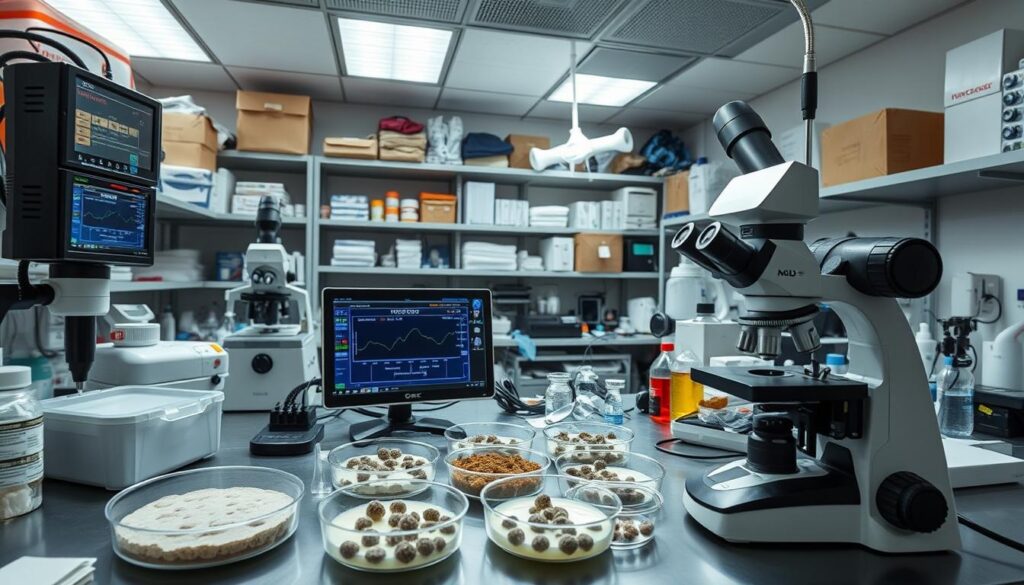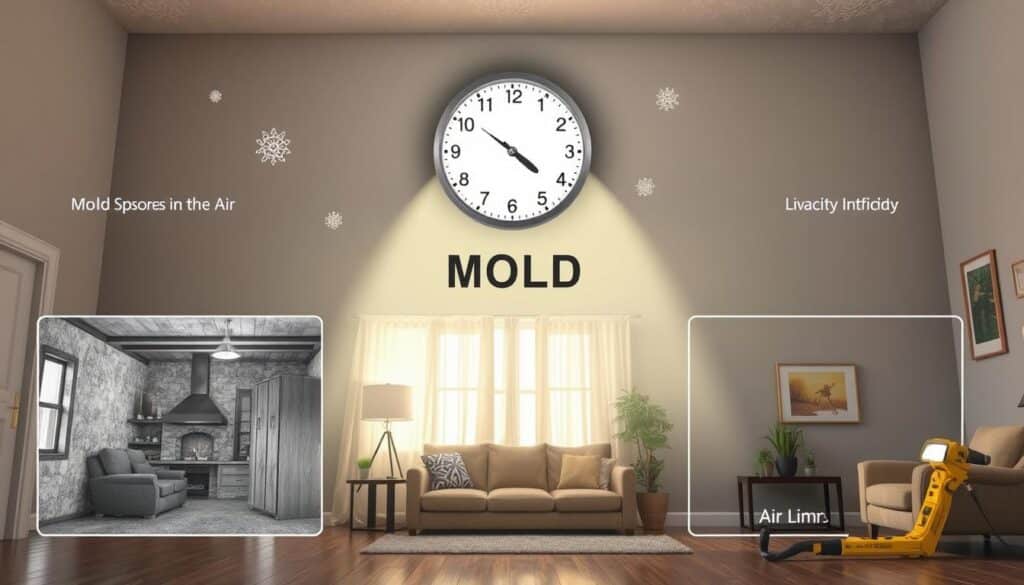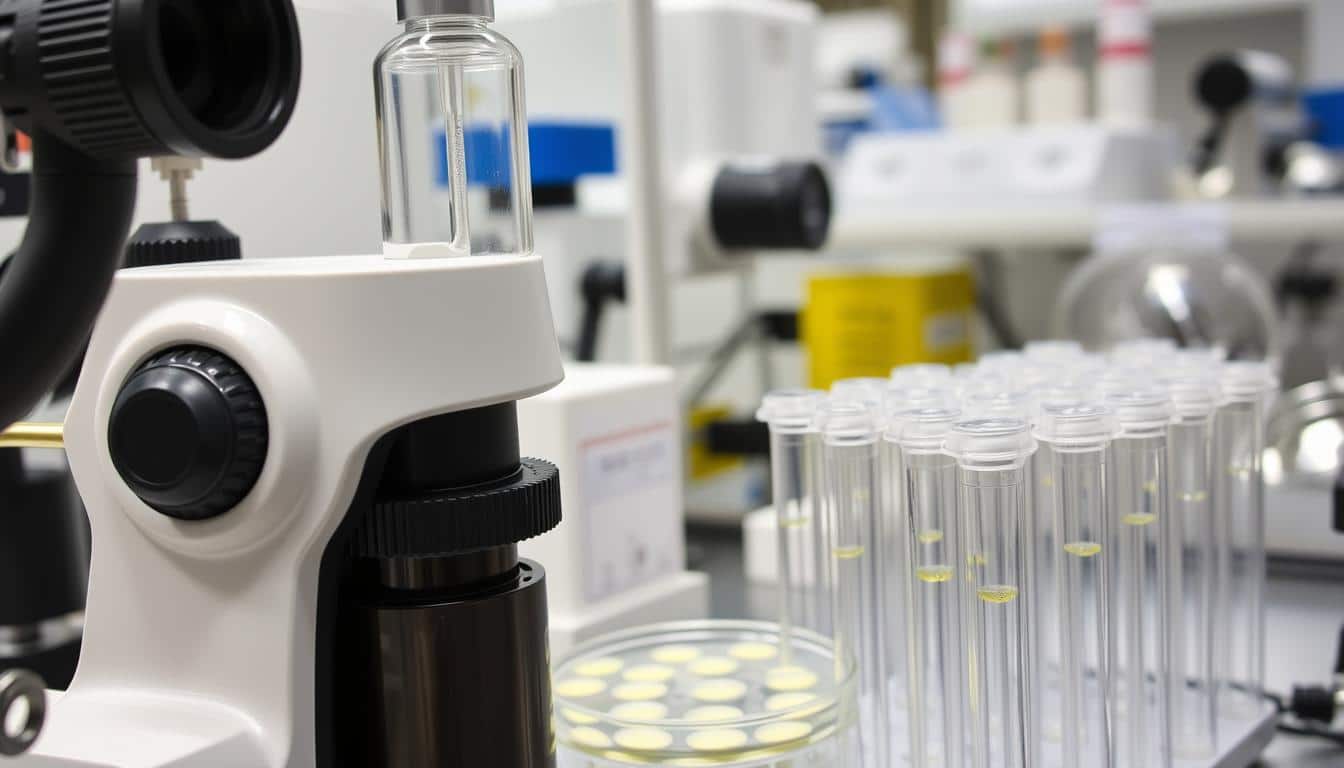Did you know that mold spores are invisible to the naked eye? This fact shows why mold air sampling is key in finding these tiny threats to our air. I’m excited to explore how we can make our homes healthier by detecting indoor spores and testing air quality.
Mold air sampling is a vital tool in mold inspections by certified pros. It’s not just about seeing mold; it’s about knowing what’s in the air we breathe. This method uses special pumps to push air through devices, catching mold spores for lab tests.
Using mold air sampling, we can figure out how big a mold problem is, what types of mold are there, and how much we’re exposed to. This info is crucial for fixing mold problems and making our homes safer.
Key Takeaways
- Mold spores are microscopic and invisible to the naked eye
- Air sampling is crucial for detecting and identifying mold spores
- Professional mold inspections often include air sampling techniques
- Laboratory analysis of air samples reveals mold types and concentrations
- Effective mold air sampling helps in creating healthier indoor spaces
Understanding the Importance of Indoor Air Quality
I spend about 90% of my time indoors, like many Americans. This fact shows how important indoor air quality is. The air we breathe at home, work, or school can greatly affect our health and well-being.
Health Risks Associated with Poor Air Quality
Poor indoor air quality can be very harmful. It can cause respiratory problems, allergies, and even lung cancer. The World Health Organization says 3.8 million people die each year from illnesses caused by bad indoor air.
Common Indoor Air Pollutants
Many pollutants can be found indoors. These include:
- Mold spores
- Radon
- Particulate matter
- Volatile organic compounds (VOCs)
- Carbon dioxide
Radon, for example, causes about 21,000 U.S. deaths from lung cancer each year. Regular checks help find these pollutants and reduce their harm.
The Role of Mold in Indoor Air Pollution
Mold grows in damp places, releasing spores that harm air quality. It can spread on walls, furniture, and carpets, making it hard to get rid of. Being exposed to mold spores can irritate the lungs, causing coughing, wheezing, and throat problems.
To keep indoor air healthy, it’s key to control humidity, ensure good ventilation, and check air quality often. These steps help spot and fix problems before they become serious health issues.
| Indoor Air Quality Factor | Recommended Range | Potential Health Impact |
|---|---|---|
| Humidity | 30% – 50% | Mold growth prevention |
| Carbon Dioxide | <1000 ppm | Improved cognitive function |
| Particulate Matter (PM2.5) | <12 μg/m³ | Reduced respiratory issues |
What is Mold Air Sampling?
Mold air sampling is a key method to find mold indoors. It uses special tools to catch mold spores in the air. The collected air is then tested in a lab.
This method helps understand the types and amounts of mold spores in your space. It’s crucial for spotting mold and health risks. I’ve seen that combining air sampling with visual checks gives a full picture of mold in buildings.
Here’s a quick look at common mold air sampling techniques:
- Spore trap testing: Captures airborne spores larger than 3 microns on a glass slide
- Direct sampling: Collects air samples directly onto a culture medium
- Andersen samplers: Uses a multi-stage impactor for size-specific spore collection
Yet, air sampling has its limits. The EPA warns that some methods, like ERMI, are still being tested. That’s why I suggest using air sampling with other methods for the best results.
Types of Mold Commonly Found in Indoor Environments
There are many indoor mold species found in homes. These fungi grow in damp areas, making our homes their ideal place to thrive. Let’s explore the most common types of mold you might find in your home.
Penicillium
Penicillium is a common indoor mold. It looks like a blue-green fuzzy patch on walls or food. This mold can cause allergies and breathing problems, so it’s important to deal with it fast.
Cladosporium
Cladosporium is found in many homes. It’s olive-green or brown and grows on fabrics and wood. While not as harmful as some molds, it can still cause skin rashes and breathing issues for some people.
Aspergillus
Aspergillus is another common mold in homes. It comes in different colors and can spread quickly. For most, it’s not harmful, but it can be dangerous for those with weak immune systems.
| Mold Type | Appearance | Common Locations | Health Effects |
|---|---|---|---|
| Penicillium | Blue-green, fuzzy | Walls, food | Allergies, respiratory issues |
| Cladosporium | Olive-green or brown | Fabrics, wood | Skin rashes, breathing problems |
| Aspergillus | Various colors | Damp areas, HVAC systems | Potential severe infections in immunocompromised individuals |
Knowing about these common molds is key to identifying them. If you think you have mold in your home, it’s best to get a professional to test and remove it.
The Science Behind Mold Air Sampling Techniques
I’ve learned that mold air sampling techniques are key for finding indoor spores. These methods use science to collect and study airborne mold particles. Let’s explore the world of microbial contamination assessment.

Mold sampling uses air pumps and special devices to catch spores. These devices, like impaction samplers, trap spores for analysis. Then, samples are checked with microscopy or culture-based methods to find and count mold spores.
One method that caught my eye is quantitative polymerase chain reaction (qPCR). It gives detailed info on mold species by looking at DNA sequences. In a study, researchers used qPCR to analyze 36 fungal species for the Environmental Relative Moldiness Index (ERMI).
The study compared dust collection methods for fungal assessment. They found strong links between the cell counts of 36 species from different dust methods. This shows the value of using many sampling techniques to understand indoor mold.
“Fungal cell concentrations of indoor associated species correlated well between all four dust sampling methods (r = 0.68–0.86, p
No link was found between air and dust fungal concentrations. This shows we need to mix different sampling methods for accurate results. Using various mold sampling techniques helps us better understand contamination and keep indoor spaces healthy.
Mold Air Sampling: Detect Indoor Spores Effectively
Mold air sampling is key to finding hidden mold and keeping our homes healthy. Air sampling devices are crucial for spotting indoor spores. Let’s look at the different mold detection tools used.
Air Sampling Devices
Air sampling devices are vital for catching airborne mold spores. They help experts figure out the types and amounts of mold in our homes. The main air sampling devices are:
- Impaction samplers
- Cassette samplers
- Airborne-particle collectors
Impaction Samplers
Impaction samplers use air pumps to catch spores on slides. This method lets experts analyze the mold in the air precisely.
Cassette Samplers
Cassette samplers, which come in disposable or reusable forms, use air to trap spores on media. They’re popular for their ease and dependability.
Airborne-Particle Collectors
Airborne-particle collectors catch spores directly on culture dishes. This method helps identify mold species and check if spores are alive.
| Sampling Method | Advantages | Limitations |
|---|---|---|
| Viable Air Sampling | Identifies exact mold species | Longer processing time, more expensive |
| Non-viable Air Sampling | Faster results, more affordable | Cannot distinguish between different species |
| qPCR Sampling | Targets DNA of 36 mold species | Specialized equipment required |
Remember, indoor spore counts are usually about 75% of outdoor counts. For the best results, it’s wise to hire certified pros. They know how to use these devices and understand the results.
When to Conduct Mold Air Sampling

Figuring out the best time for mold inspection is key. I suggest doing mold air sampling when you see mold or when it’s likely to grow. This usually happens when there’s too much moisture or water damage.
Even if you don’t see mold, it’s smart to test the air in places you use a lot and near your HVAC. This is part of keeping your air quality in check. Don’t forget to test the outdoor air too, for comparison.
Here are some times when you should get mold air samples:
- After water damage incidents
- When musty odors are present
- During routine building inspections
- Before and after mold remediation efforts
But, there are times when you shouldn’t test for mold. This includes when someone is being treated for mold exposure, during mold-related lawsuits, or if it’s not safe for the inspector.
“Thorough visual inspections or detecting problem areas by musty odors are more reliable than air sampling for mold.”
While air sampling is useful, it’s just one part of checking for mold. A full environmental mold evaluation gives a clearer picture of your air quality and mold risks.
Ideal Conditions for Mold Air Sampling
When I do mold air sampling, I look for certain conditions to get accurate results. The environment where the air quality is tested is very important. Let’s look at what makes for the best sampling protocols.
Closed Environment Sampling
I always do sampling in a closed area. This means closing all windows and doors to keep the air stable. I also turn off fans and air exchangers to reduce air movement. This helps get a true picture of the indoor spores.
Weather Considerations
Weather can really affect mold air sampling. I don’t sample during bad storms or when it’s very windy. The best time is when it’s calm and there’s little outdoor air movement.
Sampling Duration
The length of sampling is very important. I usually take samples for 5 to 10 minutes. This depends on how active the area is and how much dust there is. It gives a full view of the airborne spores.
| Factor | Ideal Condition | Impact on Sampling |
|---|---|---|
| Environment | Closed, stable | Accurate indoor spore representation |
| Weather | Calm, no storms | Minimized outdoor interference |
| Duration | 5-10 minutes | Comprehensive spore capture |
| Sample Height | 3-6 feet off ground | Representative of breathing zone |
By sticking to these rules, I make sure my mold air sampling is reliable. This helps us understand the indoor air quality better. It also helps us find and fix mold problems effectively.
Interpreting Mold Air Sampling Results
I’ve spent over 15 years looking at mold data, reviewing about 100,000 reports. Understanding mold test results is key for good air quality analysis. When I do a spore count, I compare indoor levels to outdoor ones and safety standards.
The EPA says indoor mold spore counts under 500 spores per cubic meter are normal. Counts between 501-1500 spores are low. Levels from 1501-3000 spores show a moderate concentration. Counts over 3000 spores might need cleanup, especially for people who are sensitive.
Surface sampling shows if there’s fungal growth. Results range from “No Fungal Growth” to “Fungal Growth” based on mold presence. Air sampling gives us numbers in Raw Count and Spores/M3, a standard way to measure air volume.
When I look at results, I pay attention to total spore counts and specific mold types. Counts over 600 spores/M3 for Penicillium/Aspergillus, or over 300 spores/M3 for Chaetomium, are warning signs. Any Stachybotrys presence is also a red flag. These species often mean there’s moisture issues and need quick action.
Remember, mold air sampling is just one part of air quality analysis. It’s important to look at other factors too. A full assessment is needed for accurate mold test interpretation.
Limitations and Challenges of Mold Air Sampling
Mold air sampling is useful but comes with challenges. It’s a key tool for monitoring fungal exposure. Understanding its limits helps make better decisions about indoor air quality.
Variability in Airborne Spore Levels
One big challenge is the high variability in results. Things like AC use, foot traffic, and wind can change spore levels a lot. I’ve seen samples taken just minutes apart or in different spots show very different results. This makes it hard to interpret them.
Potential for Skewed Results
Air sampling might not show the whole picture. If mold is hidden or spores are trapped, samples can miss it. This can lead to false negatives, saying everything is fine when it’s not. That’s why early detection and prevention of mold through visual checks are just as crucial as air sampling.
Identification Difficulties
It’s hard to identify mold types from air samples. Spores can get damaged during collection, making it tough to know the exact species. That’s why I always say mold air sampling should be part of a bigger assessment. It’s pricey and can be misleading if not understood by experts.
FAQ
What is mold air sampling?
Mold air sampling is a way to find and study mold spores in the air. It uses special tools to grab air samples. These samples are then checked in a lab to see what mold spores are there.
Why is indoor air quality important?
Bad indoor air can cause health problems like asthma and lung cancer. It can also affect your brain. Keeping the air clean is key to staying healthy.
What are some common types of mold found indoors?
You’ll often find Penicillium, Cladosporium, and Aspergillus mold indoors. They like damp places and can grow on many surfaces.
How do mold air sampling techniques work?
These techniques use science to catch and study mold spores in the air. They use air pumps and special samplers to collect samples. Then, labs use these samples to find and count mold spores.
What devices are used for mold air sampling?
Devices like impaction samplers and cassette samplers are used to catch mold spores. They help get accurate air samples for analysis.
When should mold air sampling be conducted?
You should do mold air sampling if you see mold or smell musty odors. Even without seeing mold, taking samples in the most used room and near the HVAC unit is a good idea.
What are the ideal conditions for mold air sampling?
The best time for sampling is when the air is still, with no wind. The room should be closed off. Sampling usually takes 5 to 10 minutes, depending on the activity and dust.
How are mold air sampling results interpreted?
Results are compared to outdoor levels and safety standards. The EPA says less than 500 spores per cubic meter is normal. More spores might mean a mold problem. Knowing the type of mold is also important.
What are some limitations and challenges of mold air sampling?
Sampling can be tricky because spore levels change and air currents can mess with results. It’s not enough on its own to find mold problems. It should be used with visual checks and surface sampling.




